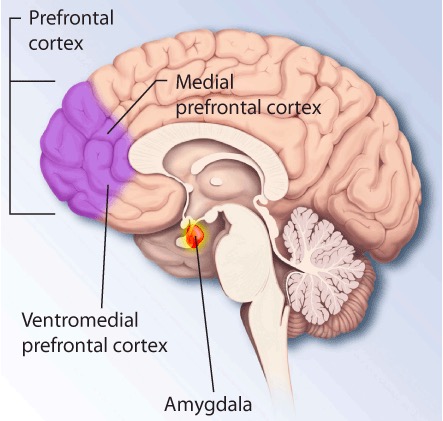Playlist
Show Playlist
Hide Playlist
PTSD: Management
-
Slides PTSD Psychiatry.pdf
-
Download Lecture Overview
00:01 So how can you treat PTSD? First line defence is using an SSRI, a selective serotonin reuptake inhibitor. 00:11 This acts by preventing the reuptake of serotonin in presynaptic neurons. 00:16 Thereby increasing the amount of serotonin in synapses. 00:21 These medications take about four to six weeks to reach maximum efficacy and some side effects to look out for included their black box warning, stomach upset, sexual dysfunction, night sweats and mood swings. 00:37 When it comes to that black box warning, what this is is a hazard warning issued by the FDA, the Food and Drug Administration. 00:45 And it explains that SSRIs are associated with an increased risk of suicidal thinking, feeling, and behavior in young people. 00:54 And it’s very important to monitor patients on SSRIs for any mood shifts or changes in their thinking, particularly any dangerous thoughts of behaviors. 01:05 You might also try using other antidepressants for a patient with PTSD, such as a tricyclic antidepressant and MAOI or other second generation antipsychotics can even be very helpful, medications like quetiapine. 01:22 Therapy is also very useful and should always be used along with medication therapy. 01:30 CBT, cognitive behavioral therapy has a lot of efficacy and proven benefits. 01:35 And also relaxation, support groups and family therapy are very useful. 01:41 Note early treatment of PTSD may prevent its chronicity. 01:45 Drug therapies have generally been most effective in decreasing hyperarousal and mood problems. 01:53 So keep that in mind when determining your management plan. 01:56 And also note that SSRIs should always be started at the low end of the therapeutic range and they can always be gradually titrated up. 02:07 Some other medication to consider include alpha-adrenergic receptor blockers, medications such as prazosin. 02:16 These help to reduce nightmares and improve sleep in the patient with PTSD. 02:21 You want to start prazosin at a very low dose such as 1 mg and then gradually titrate it upwards depending on tolerability. 02:29 And one of the things this medication can do is alter the blood pressure. 02:32 So you do want to pay close attention to side effect and make sure that patient is stable before making dose changes. 02:40 Hypotensive patients or those prone to orthostatic hypotension should be treated for this reason very, very cautiously. 02:49 Another medication that can be used to treat hyperarousal are the benzodiazepines. 02:54 However, these are used very cautiously because they do have a high addiction potential. 03:01 Exposure therapy that relies on extinction learning can also be extremely helpful to the PTSD patient. 03:09 And as another important note because you want your patient to very safe, we’ll reiterate this point given the high prevalence of comorbid substance abuse in patients with PTSD. 03:22 Benzodiazepines should be used very, very sparingly and very cautiously. 03:29 They can also cause drowsiness and sedation, which could be undesirable. 03:34 So in addition to addiction, the benzodiazepines are not considered first line because of their side effects and abuse potential. 03:44 I want to take a moment to point out the difference between acute stress disorder and PTSD. 03:50 Acute stress disorder is when a patient experiences a major traumatic event, but has anxiety symptoms for only a very short duration of time. 04:00 To qualify for this diagnosis, the symptoms must occur within one month of the trauma and lasts for a maximum of one month, but not beyond. 04:10 These symptoms are very similar to those for PTSD. 04:15 So what does this statement apply to? Acute distress disorder versus posttraumatic stress disorder, here’s a little quiz. 04:27 An event that occurred any time in the past. 04:31 Well, that can be posttraumatic stress disorder. 04:33 For acute stress disorder, remember it has to have been within one month. 04:38 Making that the correct answer to the second question. 04:41 And then when the symptoms last for less than one month and then anxiety goes away, it’s acute stress disorder. 04:49 When the symptoms last more that one month, we’re now talking about posttraumatic stress disorder. 04:57 So that’s an overview of PTSD, a pretty common anxiety disorder, one that is very treatable, but also can be extremely disabling for patients. 05:07 So very important to screen for in any one who has been exposed to any kind of trauma or life-threatening event where they felt like themselves or loved one was at risk for bodily harm and injury. 05:21 So now you know a little bit about the diagnosis and also some treatment options.
About the Lecture
The lecture PTSD: Management by Helen Farrell, MD is from the course Anxiety and Stress-Related Disorders.
Included Quiz Questions
Which of the following is NOT a side effect of the first-line agents used to treat post-traumatic stress disorder (PTSD)?
- Decreased seizure threshold
- Sexual dysfunction
- GI disturbances
- Night sweats
- Mood swings
Which of the following is used in conjunction with pharmacotherapy to treat post-traumatic stress disorder (PTSD)?
- Cognitive-behavioral therapy (CBT)
- Relational and compassionate psychotherapy
- Behavior modification
- Biofeedback
- Dialectical behavior therapy
Post-traumatic stress disorder (PTSD) pharmacotherapies have generally been most effective in decreasing which of the following?
- Hyperarousal
- Night sweats
- GI disturbances
- Sexual dysfunction
- Suicidal thoughts
Which of the following statements regarding the management of post-traumatic stress disorder (PTSD) is FALSE?
- Prazosin should be started with a dose of 3-15 mg to increase its efficacy.
- TCAs and MAOIs are used as second-line agents
- Early treatment may prevent chronicity.
- SSRIs and other drugs are most effective in improving hyperarousal and mood.
- An SSRI should be started at its lowest dose and gradually titrated.
A 20-year-old male is diagnosed with post-traumatic stress disorder (PTSD). He also has a history of substance abuse. Which of the following drug classes should be avoided in this patient due to their high addiction potential?
- Benzodiazepines
- Selective serotonin reuptake inhibitors
- Monoamine oxidase inhibitors
- Atypical antipsychotics
- Tricyclic antidepressants
The difference between acute stress disorder (ASD) and post-traumatic stress disorder (PTSD) can be explained by which of the following statements?
- PTSD symptoms last > 1 month, while ASD symptoms last no longer than a month.
- PTSD symptoms last > 1 year, while ASD symptoms last no longer than 6 months.
- PTSD symptoms last > 1 week, while ASD symptoms last no longer than 2 days.
- PTSD symptoms last > 1 week, while ASD symptoms last no longer than a month.
Customer reviews
5,0 of 5 stars
| 5 Stars |
|
1 |
| 4 Stars |
|
0 |
| 3 Stars |
|
0 |
| 2 Stars |
|
0 |
| 1 Star |
|
0 |
Very clear and to the point. But gives understanding from a beginning to an ending which builds an overall picture.




